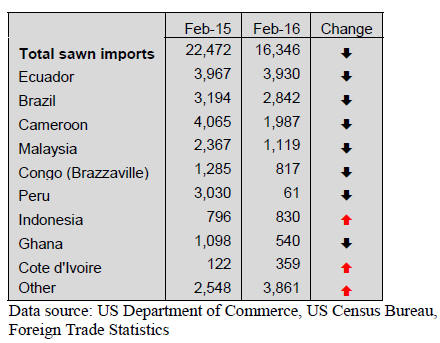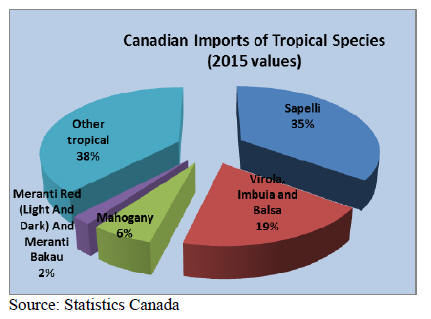|
Report from
North America
India increases tropical sawnwood exports to US
Tropical sawnwood imports from India soared to 1,218
cu.m. in February. A small portion of the imports were
teak (80 cu.m.) while the majority was ¡®other tropical¡¯
species.
US imports of sawn hardwood recovered in February
following the steep but brief decline in the previous
months. Temperate and tropical sawnwood imports were
96,307 cu.m. in February worth US$39.4 million.
Both the decline in imports and last month¡¯s rise were
primarily in temperate species.
Tropical sawnwood imports increased 13% in February to
16,346 cu.m. However, year-to-date imports were one
third lower than in February 2015.
The value of all tropical imports was US$16.4 million
with ipe imports (US$3.9 million) accounting for almost
one quarter of the total.

Ipe sawnwood imports grew 50% month-over-month to
1,962 cu.m. in February. Year-to-date imports were down
45% from February last year. Balsa remained the largest
tropical import by volume. The US imported 3,925 cu.m.
of balsa sawnwood in February, down 9% year-to-date
from February 2015.
Imports of sapelli (2,001 cu.m.) and acajou d¡¯Afrique
(1,400 cu.m.) declined in February. Sapelli imports were
also significantly down on a year-to-date basis, but with
only two months of imports in 2016 volumes can still
improve significantly.
Mahogany imports (1,027 cu.m.) were up in February,
both month-over-month and year-to-date. Imports of
keruing sawnwood (948 cu.m.) declined again after a brief
increase in January.
Brazil increased the volume of sawn hardwood shipments
to the US by 37% in February, helped by a favorable
exchange rate. The largest increase was in ipe shipments,
but US imports of jatoba and virola from Brazil also grew.
Despite the overall decline in US imports of sapelli in
February, Cameroon¡¯s sapelli shipments increased to
1,210 cu.m.
Sawnwood imports from Malaysia were down more than
one third in February to 1,119 cu.m. Imports of keruing
from Malaysia fell from 1,336 cu.m. in January to just 689
cu.m. in February.
Canadian tropical sawnwood imports from Brazil rise
Canadian imports of tropical sawnwood were almost
unchanged in February at US$1.74 million. Year-to-date
imports were up 22% from February 2015.
At US$563,037 sapele accounted for the majority of
Canadian imports of tropical sawnwood. Sapele imports
grew 16% month-over-month and 5% year-to-date.
Imports of meranti sawnwood grew to US$12,456, but the
value of year-to-date imports is lower than in February last
year. Brazil expanded exports also to Canada in February.
Sawnwood imports from Brazil were worth US$233,171,
more than double year-to-date from February 2015.
Cameroon remained Canada¡¯s largest source of tropical
sawnwood imports at US$565,932 in February.
 
C$1 billion for clean technology in Canada¡¯s federal
budget
The Forest Products Association of Canada has applauded
the federal government¡¯s budget. The budget, released in
March, includes C$1 billion funding over four years to
invest in clean technology in the forest industry and other
resource-based sectors.
Another C$2 billion is earmarked for a Low Carbon
Economy Fund and C$40 million for changes to the
country¡¯s building codes to support climate change
mitigation.
The clean technology funding will support innovation in
the forest industry, in particular the development and
commercialisation of bio-products that replace materials
made from fossil fuels. Some building code changes have
the potential to support greater wood use.
World¡¯s tallest wood building under construction in
Canada
An 18-storey building is being in built in Vancouver using
heavy cross-laminated timber beams (mass timber). The
building will be a student residence at the University of
British Columbia. The building is meant to showcase the
use of mass timber and its price competitiveness with
concrete construction in high rise buildings.
See:
http://news.ubc.ca/2015/10/01/new-ubc-student-residence-to-beamong-
worlds-tallest-wood-buildings/
The building code allows construction in wood only up to
six stories in British Columbia. In the US the limit is five
stories. Designs for taller wood buildings need to
demonstrate they can meet required fire, seismic and
safety standards.
According to the news portal Business in Vancouver, the
¡®mass¡¯ timber components are prefabricated. Because of
this construction time is reduced by a few months
compared to concrete high rises.
Presently, wooden high rise construction remains costly
because of limited material supply and the general lack of
experience of construction workers. If prefabricated
designs are more widely used costs would decline
significantly.
The wooden high rise building currently being built uses
concrete and steel for some portions of the building such
as the ground floor, interior stairways and the roof to
reduce cost while meeting building standards.
Several 8-10 story wood buildings have been built in
Australia, Austria, Canada and the UK. A 14-story
wooden apartment building is under construction in
Norway.
Land use agreement protects 85% of 6.4 millionhectare
rainforest from logging
Two decades of environmental and indigenous conflict
over potential industrial use of 6.4 million ha. of forest on
the central and north Pacific coast of British Columbia,
Canada has ended.
In February this year the 26 First Nations of the region, the
British Columbia government, industry and environmental
groups held a ceremony to celebrate a land use order and
several related protocols.
Fifteen percent of the area will be open to industrial
logging, while the First Nations will receive forest tenure
for public land. Carbon credit projects, renewable energy
and tourism development are also being considered by the
local communities. The area concerned, known as the
Great Bear Rainforest, is one of the largest remaining oldgrowth
temperate rainforests in the world.
|